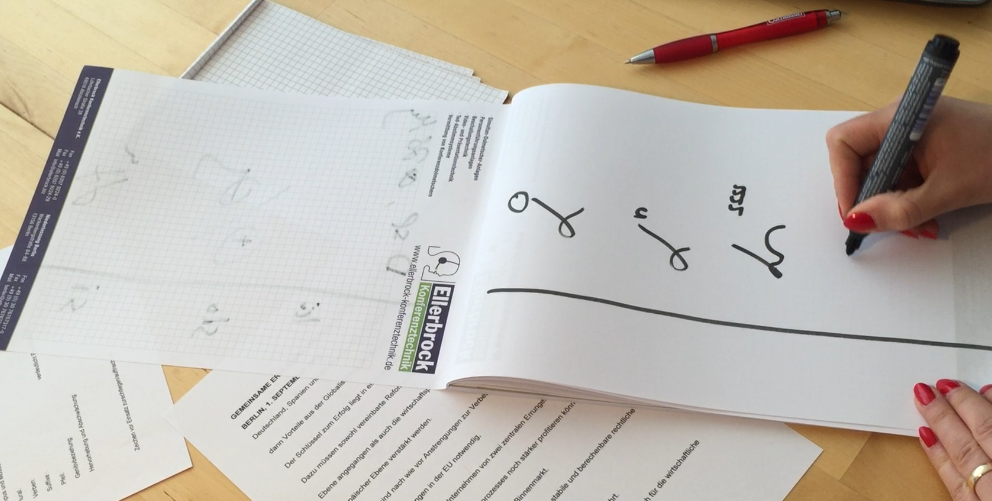Note Taking Technique Versus Shorthand – Why do interpreters not simply learn shorthand?
The two basic, though quite different, principles of the note taking technique as compared to shorthand are as follows: The note taking technique is aimed at just conceiving the meaning and serving as a support for the thinking. The system of shorthand note taking is writing down every single original word. It can be read and understood even years later.
If we had to take down a speech in shorthand and then tried to interpret this speech, we would remain very close to the source text and this does generally not allow a good interpretation.
It would take us too much time to read a sentence completely and then rethink and set it up in the target language in our mind. Nevertheless, a number of symbols used in shorthand are quite suitable for being used in interpreting and can even serve as an inspiration to find personal symbols.

Which language to use in note taking?
The specialized literature gives controversial information and hints on the reference language that should be used in note taking: the source language, the target language, the mother tongue, or a mixed language system?
As far as I am concerned, only the mixed language system is realistic and makes sense. Firstly, certain words and expressions in specific languages are virtually predestined for being used as short symbols. I am not an interpreter of English, but I use the English “I” to represent the German “Ich”. And I use the Spanish “y” for “and” (German “und”).
If I have to interpret into German, I use to note down technical terms which already come to my mind in listening, as shortcuts or completely in German. Later, when I speak, this saves me the time for searching this technical term in German. If I take down the same technical term in the source language, I virtually stick to this term in my mind and I will simply not remember the correct translation.
Even though, ‘language-neutral’ concepts and symbols should make up the major part of the note taking, because this is the only way to write down as much of content as possible with only one or a few symbols, thus saving time. Abbreviations of complete words are generally much longer and involve a risk of confusion.

What kind of writing pad should I use for interpreting?
It sounds trivial, but a writing pad with sheets difficult to turn over and too small or difficult in size, could make you ‘goof up’ your intervention. When it comes to interpreting, we must concentrate fully i.e. 100% on our task. Everything that could side-track or confuse us will prevent us from keeping the full amount of ‘thinking capacities’ we need for our real task.
DIN A 5 has proven useful as a size of a pad for note taking.
Please make sure that its sheets can turn over easily and cannot get caught.

The structure of the writing pad used in interpreting
The interpreter’s pad is divided into two parts by a vertical line before interpreting begins. This allows us noting down for instance important units of sense and meaning on the left-hand side, and the real contents on the right-hand side. This allows us recognizing the structure of the speech at first glance and makes us remember the details of the speech. If we did not divide the writing pad up into two parts, we would have to read the notes almost like a normal text – and this takes too much time and does not leave a good impression on the audience.
The Signs and Symbols
The symbols must be noted down in a clearly legible and well-structured manner, so that they are recognizable at first glance and prevent too much thinking during interpreting.
The signs and symbols used in the note taking technique should also be easy and simple to write down. Different signs and symbols should not be too similar, because otherwise, they will be mixed up or misunderstood. The same is true for shortcuts and abbreviations. In the daily routine, an interpreter is often tempted to quickly and simply cut down the words to abbreviations. This, however, could prove detrimental later during consecutive interpreting. Then suddenly you may start reflecting about the real meaning of “ecc.”, “act” or “umg.”.
